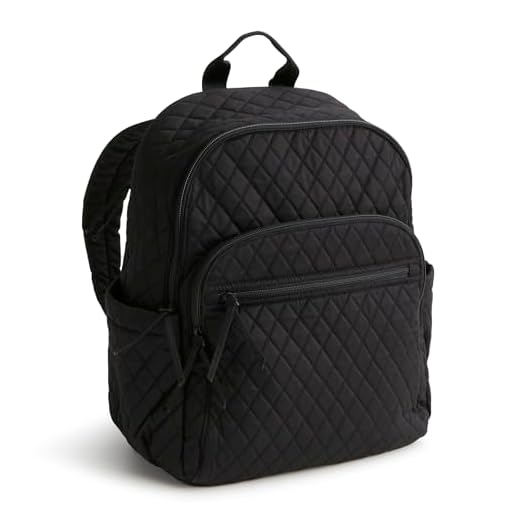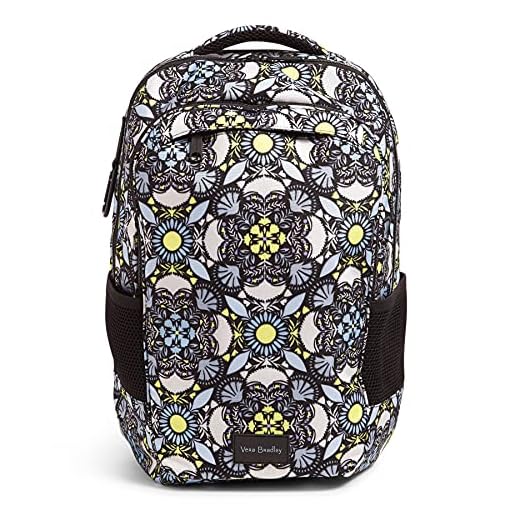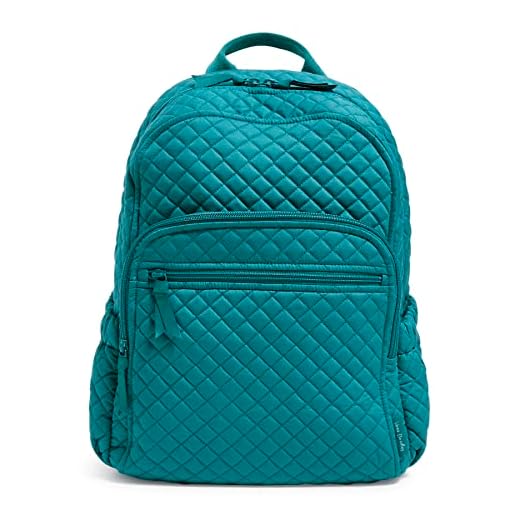



New quilted packs commonly list at $80–$140 depending on size and trim: mini crossbody-style pieces usually retail $45–85, standard daypacks $80–140, and larger travel versions or leather-trimmed editions $140–220. Limited-run prints and collaborations can climb to $200–300+. Outlet and clearance markdowns routinely push prices down to $35–75.
Resale markets show a wide spread: well-kept used items frequently trade for $15–60; sought-after patterns or near-new condition pieces trade $70–150. Expect median resale around $35; condition, print rarity and included tags drive price swings more than age alone.
Choose by need: for commute use prioritize a padded laptop sleeve (+$10–20 on many models) and sternum or padded straps for heavier loads; for travel pick a larger-volume style with zippered organization and an external luggage pass-through (these features add roughly $15–40). If budget is under $60, target last-season outlet stock or certified preowned listings.
Smart-buy tips: compare full-price listings to department-store sale windows (15–30% off), check outlet/clearance pages for 40–70% discounts, and inspect resale photos for wear on straps and zippers. Verdict: pay $80–140 for a new patterned quilted piece with modern features; pay $30–75 to score the same look on sale or used.
Price guide for quilted daypacks
Aim for $45–75 for small quilted daypacks; classic campus-size patterns usually list for $80–140; limited prints and leather-trimmed editions commonly fetch $150–260 at full price.
Materials and sizing influence price: quilted cotton models are the lightest and most affordable, microfiber/nylon blends add water resistance (+$10–30), and leather accents increase cost by $30–80. Typical capacities run 8–12 liters for mini styles, 15–22 liters for standard daypacks; empty weights span about 0.6–1.0 kg for full-size pieces.
Best purchasing tactics
Shop factory outlets and seasonal sale events to shave 30–50% off MSRP; targeted times include back-to-school, late-summer clearance and Black Friday. Compare brand-site pricing with department stores and authorized retailers before buying. Use coupon sites, cashback services and credit-card perks to reduce effective spend by another 5–15%.
Preowned, returns and verification
Secondhand markets (eBay, Poshmark, Mercari) offer like-new items from $25–90 depending on print rarity; expect rare prints to command higher resale values. When buying used, request close-up photos of quilting, zippers and interior labels; measure dimensions and confirm strap condition. For returns and authenticity checks, rely on authorized sellers and retain receipts.
If you need complementary gear for wet weather or outdoor campus use, consider a best cheap offset patio umbrella for covered seating areas and a compact option like the best ladies folding umbrella for daily carry.
Price ranges by collection and retail channel
For a daily daypack with laptop pocket, expect to pay between $88 and $178 at full retail; hunt outlets or discount chains to find the same styles for $24–$95.
By collection
- Lighten Up (quilting nylon): typical retail $79–$120; mini versions $68–95; outlet/clearance $35–85. Best for commuters who want lightweight construction.
- Signature Cotton (classic quilted cotton): typical retail $118–158; larger or laptop models $148–178; sale prices often fall to $70–120.
- Campus / Everyday: typical retail $78–108; student-oriented styles with organizational pockets usually retail $88–128; outlet finds $40–80.
- Performance / Active: typical retail $68–98; water-resistant fabrics and simpler trims reduce base price compared with cotton lines.
- Leather-trimmed / Full leather: typical retail $198–350; limited editions or full-leather models can exceed $300 at specialty retailers.
- Mini / Crossbody variants: typical retail $48–110; frequent markdowns to $25–70 at clearance and off-price stores.
- Limited editions & collaborations: retail $150–300+; resale for sold-out patterns commonly reaches $200–400 depending on rarity.
By retail channel
- Brand stores & official website: pay full MSRP ranges listed above; expect regular promotions that lower prices by about 15–40% during promotional periods.
- Department stores: prices generally match brand MSRP; during store sales typical reductions put many styles in the $70–140 range.
- Factory outlets: short-season or excess inventory usually priced 30–60% below MSRP; common outlet range $35–120 depending on collection.
- Off-price retailers (TJ Maxx, Marshalls): surprise finds priced $24–90; stock is irregular and varies by location.
- Online marketplaces (Amazon, eBay): new items $60–160; used or preowned listings span $15–120 – verify seller ratings and return policy.
- Secondhand platforms (Poshmark, ThredUp): everyday resale $15–90; rare patterns or near-new condition push prices higher.
- Specialty boutiques: markup of about 10–25% over MSRP for exclusive regional stock or bundled services (monogramming, gift packaging).
Recommendation: set a target price based on intended use – under $90 for lightweight or occasional use (seek outlets/discount stores), $90–150 for reliable daily carry (brand or department store sales), and $150+ for leather, large laptop models, or limited runs (buy at full retail or resale for rare pieces).
Average cost of popular styles (Campus, Lighten Up, Carson)
Budget $70–110 for Campus; $50–85 for Lighten Up; $95–140 for Carson for standard new models.
Median and sale figures
Median retail price: Campus $90; Lighten Up $65; Carson $115.
Typical sale ranges: Campus $45–70; Lighten Up $30–50; Carson $60–90.
Price drivers and buying targets
Quilted signature fabrics add about $10–30; leather trims or limited-edition materials add $40–80; larger laptop-friendly Carson variants list roughly 20% above base Carson price.
Target purchase thresholds: buy Campus under $80, Lighten Up under $50, Carson under $100 for solid value. Preowned market: well-kept Campus sell $30–60; Lighten Up $20–40; Carson $40–80; expect lower prices for visible wear or missing accessories.
Material and Size: Effects on Sticker Price
Pick quilted polyester in a standard capacity (15–22 L) for the best balance of price and durability: typical retail tags range $65–$95. Go for lightweight nylon to shave roughly $10–$30 off that tag. Full-grain leather or heavy waxed-cotton constructions add $80–$180; leather trim alone usually tacks on $30–$80.
Material cost breakdown
Polyester (quilted): baseline; expect MSRP +0. Lightweight nylon (water-resistant): -10% to -25% relative to baseline. Cotton-canvas: +15% to +45% depending on weight and lining. Faux leather: +20%–+50%. Real leather (full panels): +80%–+200% versus polyester depending on leather grade. Hardware upgrades (metal zippers, reinforced bases, metal feet): add $10–$50 to the tag. Specialty coatings (waterproofing, stain guard) add $8–$35.
Size tiers and expected sticker adjustments
Mini (6–10 L): typical tags $40–$65. Standard/daypack (15–22 L): $60–$120. Large/commuter (25–35 L): $80–$160. Weekender/duffel-style (>35 L): $110–$240. Each size step up normally increases MSRP by $20–$60; combined material upgrades multiply that increment (for example, a large bag in leather can be $100+ above a large polyester model).
Recommendations: for daily campus or work use choose standard size in polyester or nylon; for travel or longevity pick larger capacity with reinforced base and leather or waxed-cotton panels. For stain removal and spot treatment consult practical guides such as can i use red wine vinegar instead of white vinegar.
Where to buy cheaper: outlets, online deals, and clearance
Head straight to factory outlets and the official online clearance page for the largest discounts – typical reductions by channel: outlets 35–70% off, brand clearance pages 40–75%, off-price retailers 25–50%, flash-sale sites 20–60%.
Actionable steps: subscribe to the brand’s email for exclusive clearance codes, enable app notifications for app-only promos, combine store coupons with cashback services (example: Rakuten 2–10% + 15% clearance code), and set price alerts on deal trackers and resale apps.
Outlet store reality: inventory is mainly past-season prints, factory seconds, and overstock. Inspect seams, zipper pulls, and interior lining; request a receipt and confirm the return window (many outlet purchases are final sale). Best times to visit: end-of-season weekends and federal holiday sales when outlets apply additional markdowns of 10–25%.
Online clearance tips: filter for “final sale” vs “returnable,” sort by discount percentage, and check for sitewide promo codes during holiday events (Labor Day, Black Friday, Cyber Monday). Use browser coupon extensions and stack with cashback to add 5–20% extra savings.
Resale and marketplace strategy: search eBay, Poshmark, Mercari for recent listings with clear photos and seller ratings above 98% – expect 30–70% off retail for gently used items. Ask sellers for close-ups of interior labels, hardware logos, and receipts to confirm authenticity; avoid listings priced unrealistically low.
| Channel | Typical discount | Best timing | Quick tip | Primary risk |
|---|---|---|---|---|
| Factory outlets | 35–70% off | End-of-season, holiday weekends | Inspect item in person; ask about factory seconds | Final-sale items, limited returns |
| Official online clearance | 40–75% off | Holiday sales, site refreshes | Apply promo codes + cashback | Final-sale listings, stock may be limited |
| Off-price retailers (T.J. Maxx, Marshalls, Ross) | 25–50% off | Mid-week restocks, post-holiday | Visit frequently; inventory rotates daily | Inconsistent selection, mixed conditions |
| Flash-sale and deal sites | 20–60% off | Members-only events, daily deals | Sign up for alerts; act fast on limited runs | Short return windows |
| Resale marketplaces (eBay, Poshmark, Mercari) | 30–70% off (used) | Anytime; check new listings daily | Buy from high-rated sellers; request extra photos | Counterfeits or undisclosed wear |
| Department store clearance | 20–50% off plus coupons | Seasonal markdowns, holiday sales | Stack store coupons and credit-card offers | Smaller selection of prints/styles |
Assessing fair used prices: condition, age, and rarity
Set the asking price using this formula: Asking price = recent sold median × condition multiplier × rarity multiplier × age multiplier. Use the sold-price median from the last 90 days on marketplaces as the baseline.
Condition grading and suggested multipliers
Mint / NWT: 0.85–0.95 – tags attached; no wear; hardware bright; small window for premium pricing if pattern scarce. Excellent: 0.65–0.80 – light surface wear, no stains, full function. Good: 0.45–0.60 – visible scuffs, minor lining marks, straps intact. Fair: 0.20–0.40 – staining, hardware tarnish, odor present but repairable. Poor: 0.05–0.15 – broken zippers, detached straps, structural collapse; sold for parts or restoration.
Fault-specific adjustments to apply on top of grade multipliers: small scuff or surface pilling -5% to -10%; lining stain -10% to -25%; strap fraying -15% to -30%; non-functional zipper -40% to -70%; heavy smoke/mold odor -20% to -50% (specify in listing and reduce price accordingly).
Rarity and age adjustments plus practical example
Common prints or repeated seasonal designs: multiplier 0.9–1.0. Retired fan-favorite prints: 1.1–1.6 depending on demand. Limited editions, collaborations, collegiate or PR releases: 1.5–2.5 when confirmed scarce. Vintage pieces (15+ years) with intact hardware and original tags: 1.2–2.0 if pattern collectible; otherwise use 0.9–1.1.
Example calculation: baseline sold median = $90; grade = Excellent (0.75); rarity = Retired print (1.3); age factor = 1.05 → 90 × 0.75 × 1.3 × 1.05 = $92. List range: $90–110 depending on presentation and shipping terms.
Quick inspection checklist for final pricing: confirm zipper function, verify strap stitching, check lining for stains, smell-test for odors, photograph hardware up close, capture pattern placement. Log each fault and apply the percentage deductions above before setting a firm price.
When to buy: seasonal sales and coupon strategies to lower cost
Buy during end-of-season clearance windows–late December through January and late July through August–where patterned quilted daypacks frequently drop 40–70% off original tags.
Expected sale calendar and typical discounts: January clearance (40–70%); Presidents’ Day and Memorial Day promos (25–40% on select lines); Prime Day/July flash events (20–40%); late July–August back-to-school mark-downs and bundle deals (20–50%); Black Friday/Cyber Monday (25–50% sitewide plus doorbusters); late November into early December pre-holiday promotions (15–35% with free shipping).
Coupon and stacking tactics that produce the largest savings: 1) sign up for the label’s email for first-order promo codes (commonly 10–15%); 2) install a coupons-and-cashback extension (Rakuten, Honey, Capital One Shopping) to auto-apply codes and capture 2–10% cashback; 3) buy discounted e-gift cards on secondary marketplaces (Raise, CardCash) to add an effective 5–15% reduction before checkout; 4) use app-only flash codes and loyalty-member offers (extra 10% or free shipping); 5) combine a site promo code with a manufacturer discount only when terms permit–check exclusions carefully.
Practical example with numbers: item MSRP $150. Store sale 30% → $105. Add email/app code 15% off sale price → $89.25. Pay using a gift card bought at 10% discount (you paid $90 for a $100 card, effectively taking another 10% off) → effective price ≈ $80.33. Apply 5% cashback rebate after purchase → final net ≈ $76.31 (total reduction ≈ 49%).
Pre-purchase checklist: verify promo code terms (exclusions, minimums, expiry), compare site price to major retailers for possible price-adjustment windows, stack a cashback offer before checkout, buy discounted gift cards only from reputable resellers, and save screenshots/confirmation numbers for returns or price-match requests.







